Charge-separation in panchromatic, vertically positioned bis(donor styryl)BODIPY–aluminum(iii) porphyrin–fullerene supramolecular triads†
Abstract
Three, broad band capturing, vertically aligned supramolecular triads, R2-BDP-AlPorF3←Im-C60 [R = H, styryl (C2H2-Ph), C2H2-TPA (TPA = triphenylamine); ← = coordinate bond], have been constructed using BODIPY derivative (BDP, BDP-Ph2 or BDP-TPA2), 5,10,15,20-tetrakis(3,4,5-trifluorophenyl)aluminum(III) porphyrin (AlPorF3) and fullerene (C60) entities. The C60 and BDP units are bound to the Al center on the opposite faces of the porphyrin: the BDP derivative through a covalent axial bond using a benzoate spacer and the C60 through a coordination bond via an appended imidazole. Owing to the bis-styryl functionality on BDP, the constructed dyads and triads exhibited panchromatic light capture. Due to the diverse absorption and redox properties of the selected entities, it was possible to demonstrate excitation wavelength dependent photochemical events. In the case of the BDP-AlPorF3 dyad, selective excitation of BDP resulted in singlet–singlet energy transfer to AlPorF3 (kEnT = 1.0 × 1010 s−1). On the other hand, excitation of the AlPorF3 entity in the BDP-AlPorF3←Im-C60 triad revealed charge separation leading to the BDP-(AlPorF3)˙+-(C60)˙− charge separated state (kCS = 2.43 × 109 s−1). In the case of the Ph2-BDP-AlPorF3 dyad, energy transfer from 1AlPorF3* to 1(Ph2-BDP)* was witnessed (kEnT = 1.0 × 1010 s−1); however, upon assembling the supramolecular triad, (Ph2-BDP)-AlPorF3←Im-C60, electron transfer from 1AlPorF3* to C60 (kCS = 3.35 × 109 s−1), followed by hole shift (kHS = 1.00 × 109 s−1) to Ph2-BDP, was witnessed. Finally, in the case of the TPA2-BDP-AlPorF3←Im-C60 triad, only electron transfer leading to the (TPA2-BDP)˙+-AlPorF3←Im-(C60)˙− charge separated state, and no energy transfer, was observed. The facile oxidation of Ph2-BDP and TPA2-BDP compared to AlPorF3 in the latter two triads facilitated charge separation through either an electron migration or hole transfer mechanism depending on the initial excitation. The charge-separated states in these triads persisted for about 20 ns.



 Please wait while we load your content...
Please wait while we load your content...